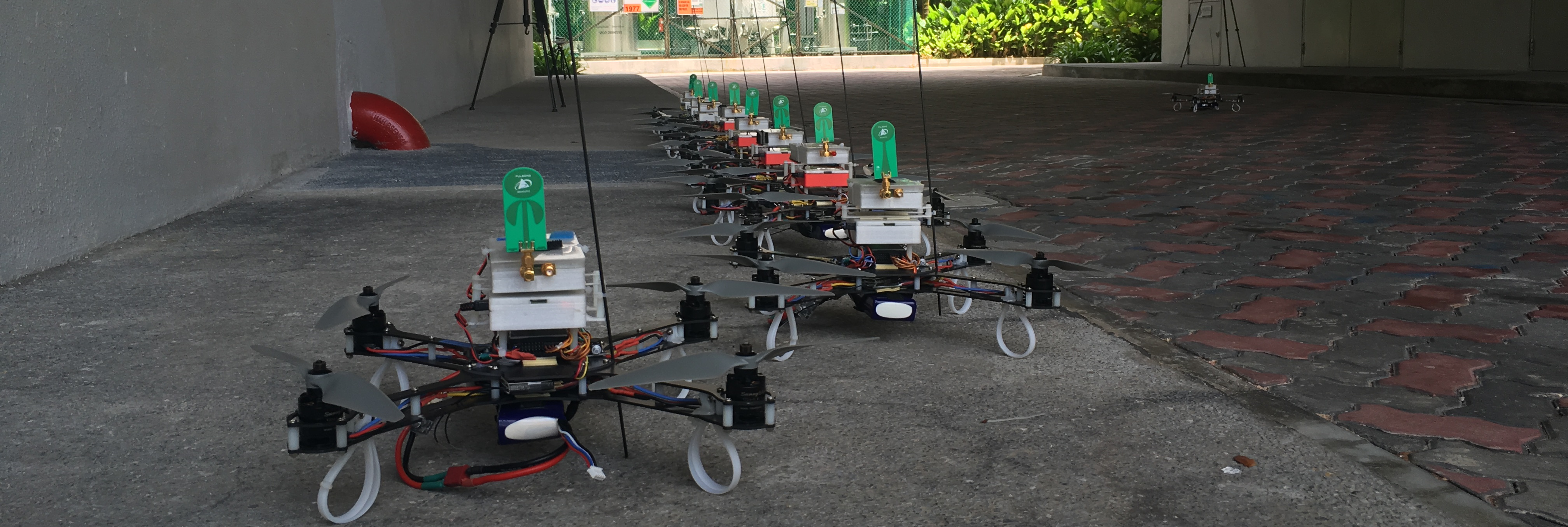Research
VIRAL-Fusion: A Visual-Inertial-Ranging-Lidar Sensor Fusion Approach
We investigate a comprehensive sensor fusion scheme to integrate an extensive set of sensor data, namely stereo camera images, 6 DoF IMU data, body-offset range measurements, and multiple lidar odometry outputs. An optimization framework is developed to estimate the robot position-orientation-velocity states from IMU preintegration, attitude-coupled UWB ranges, and Onboard Self-Localization observations. Thanks to the use of body-offset ranging technique, the VIRAL method can output global localization information in both positional and rotational states. We demonstrate the efficacy and effectiveness of the method via a wide range of experiments: public datasets, high-fidelity graphical-physical simulator, and real world data.
Reference(s):
VIRAL-Fusion: A Visual-Inetial-Ranging-Lidar Sensor Fusion Approach
Thien-Minh Nguyen, Muqing Cao, Shenghai Yuan, Yang Lyu, Thien Hoang Nguyen, Lihua Xie
Submitted to IEEE TRO, 2020.
LIRO: Tightly Coupled Lidar-Inertia-Ranging Odometry
Despite many progresses in the hardware and software designs, estimation drift and dependence on availablity of feature in the environment are still some of the biggest challenges for Lidar-based localization solutions. To resolve these issues, we investigate the fusion of range measurements to some fixed landmarks with Lidar and IMU measurements. We show that by using only two or three UWB anchors that can be quickly and easily deployed in the environment, estimation drift and robustness of Lidar-Inertia-based localization can be greatly improved. We demonstrate the effectiveness of the method via some real world experiments.
Reference(s):
LIRO: Tightly Coupled Lidar-Inertia-Ranging Odometry
Thien-Minh Nguyen, Muqing Cao, Shenghai Yuan, Yang Lyu, Thien Hoang Nguyen, Lihua Xie
Submitted to ICRA 2020.
PEARL-TVF: Persistently-Excited Adaptive Relative Localization and Time-Varying Formation of Robot Swarms
In this paper we investigate the problem of controlling a multi-robot team to follow a leader in formation without relying on external localization system. The main challenge of the problem, which is to simultaneously fulfill both relative localization and control tasks, is efficiently and novelly resolved by embedding a distance-displacement-based persistently excited adaptive relative localization technique into a time-varying formation with bounded control input (PEARL-TVF). By assuming that the leader is globally reachable and selecting proper parameters, it is shown that PEARL-TVF ensures exponentially convergent relative localization and formation errors when the leader’s behavior is deterministic, and bounded formation error for a non-deterministic leader.
Reference(s):
Persistently-Excited Adaptive Relative Localization and Time-Varying Formation of Robot Swarms
Thien-Minh Nguyen, Zhirong Qiu, Thien Hoang Nguyen, Muqing Cao, Lihua Xie.
IEEE Transactions on Robotics, 2019.
Distance-based Cooperative Relative Localization for Leader-following Control of MAVs
In this work we investigate a problem of simultaneous relative localization and leader-following control of aerial robots by using only distance and odometry sensors, thus forgoing the need of any external position system. To tackle this challenge, we propose a cooperative localization scheme based on persistent excitation condition which facilitates exponential convergence of both relative localization and tracking errors.
Reference(s):
Distance-based Cooperative Relative Localization for Leader-following Control of MAVs
Thien-Minh Nguyen, Zhirong Qiu, Thien Hoang Nguyen, Muqing Cao, Lihua Xie.
IEEE Robotics and Automation Letters, 2019 (the contents of this paper are selected by IROS’19 Program Committee for presentation at the Conference).
Download the IROS2019 slides here
Integrated UWB-Vision Approach for Autonomous Docking of UAVs in GPS-Denied Environments
In this paper we propose a method combining Ultra-wideband (UWB) ranging sensor with vision-based techniques to achieve both autonomous approaching and landing capabilities in GPS-denied environments.
Reference(s):
Integrated UWB-Vision Approach for Autonomous Docking of UAVs in GPS-Denied Environments
Thien-Minh Nguyen, Thien Hoang Nguyen, Muqing Cao, Zhirong Qiu, Lihua Xie
2019 IEEE International Conference on Robotics and Automation (ICRA), Montreal, QC, Canada.
Robust Target-relative Localization with Ultra-Wideband Ranging and Communication
Thien-Minh Nguyen, Abdul Hanif Zaini, Chen Wang, Kexin Guo, and Lihua Xie
2018 IEEE International Conference on Robotics and Automation (ICRA), Brisbane, QLD, Australia, (pdf).
Post-Mission Autonomous Return and Precision Landing of UAV
Thien Hoang Nguyen, Muqing Cao, Thien-Minh Nguyen, Lihua Xie
2018 15th International Conference on Control, Automation, Robotics and Vision (ICARCV), Singapore.
Single landmark Distance-based Navigation
Given a landmark placed at an arbitrary location, we develop an integrated estimation-control scheme to simultaneously accomplish two objectives: relative localization using only distance and odometry measurements, and navigation to the desired location under bounded control input.
Reference(s):
Single Landmark Distance-based Navigation
Thien-Minh Nguyen, Zhirong Qiu, Muqing Cao, Thien Hoang Nguyen, Lihua Xie.
IEEE Transactions on Control Systems Technology, 2019.
An integrated localization-navigation scheme for distance-based docking of UAVs
Thien-Minh Nguyen, Zhirong Qiu, Muqing Cao, Thien Hoang Nguyen, Lihua Xie
2018 IEEE/RSJ International Conference on Intelligent Robots and Systems (IROS), Madrid, Spain, (pdf).
GPS-less Localization and Path-planning for UAV Inspection of 3D Structures.
A project under NRF STE-NTU Corp Lab Program (CRP10A). In this work Ultra-wideband based localization system and model based optimization path planning techniques are developed for inspection of 3D objects using drones in GPS-denied environments.
Reference(s):
An Ultra-Wideband-based Multi-UAV Localization System in GPS-denied environments
Thien Minh Nguyen, Abdul Hanif Zaini, Kexin Guo, and Lihua Xie
2016 International Micro Air Vechicle Competition and Conference (IMAV), Beijing, China, (pdf).
(Scan the QR below for quick navigation)


